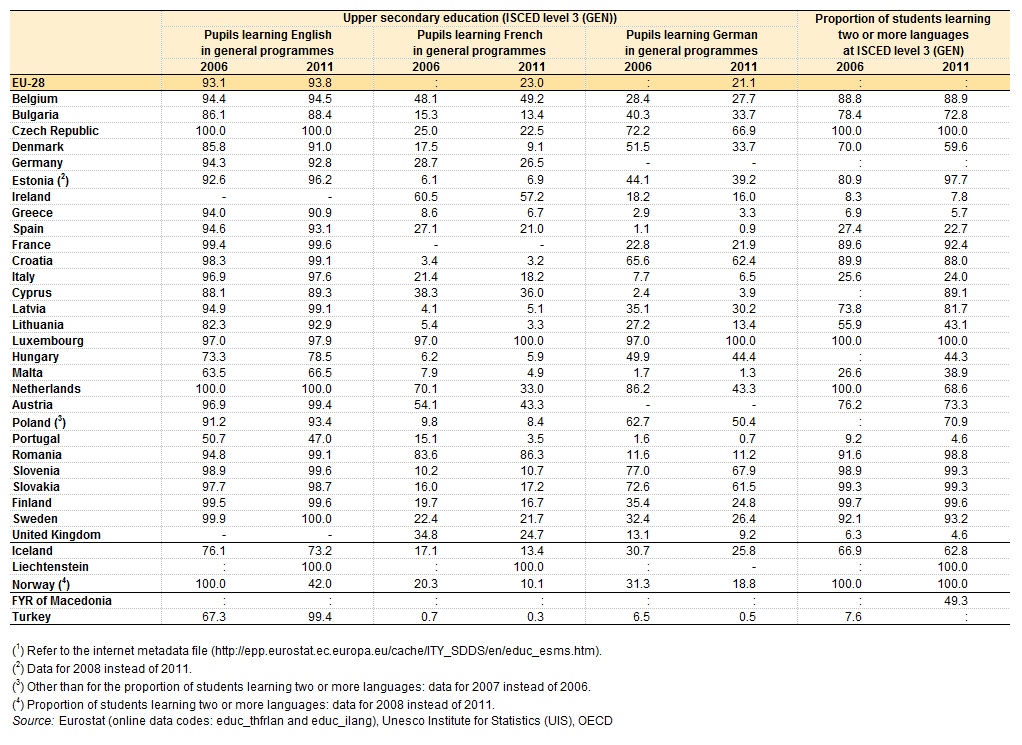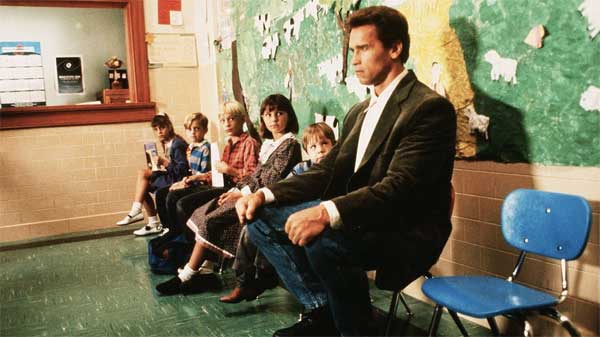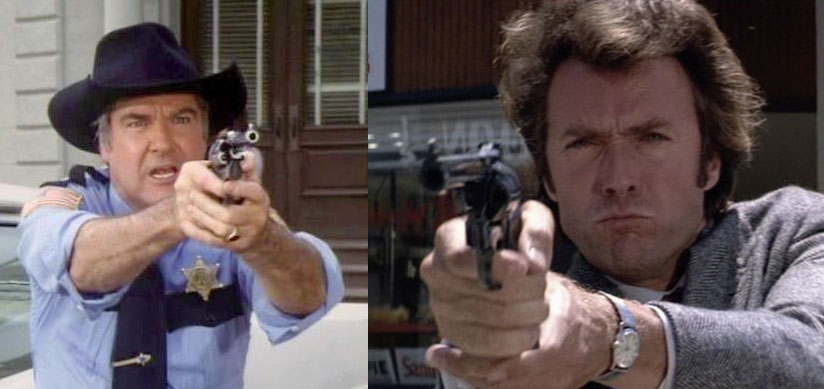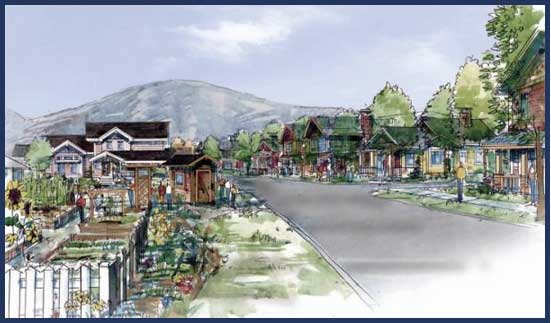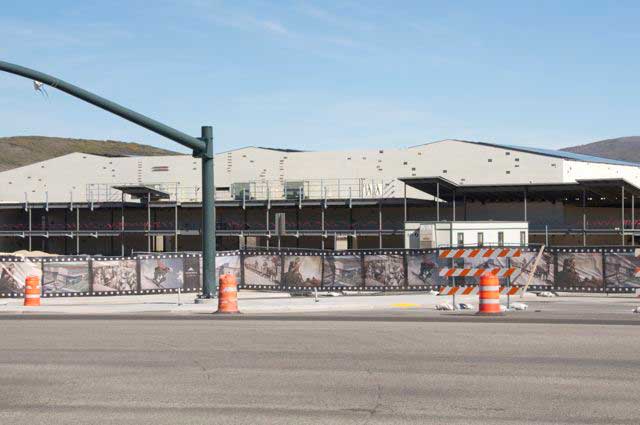During yesterday’s school board discussion regarding dual immersion, it was stated that Europe’s standard is that students learn two foreign languages. Is that true?
“The standard now for Europe is that kids know 3 languages, 2 plus their own.”
-Update on the status of dual immersion 10/7/2014 Park City School Board Meeting
Dual immersion seems to be a hot topic with many people concerned about it for different reasons. Some are worried because their kids can’t get in. Some are worried because class sizes may be bigger in non-dual immersion classes. Some are worried about whether the best teachers are teaching dual immersion. It’s most definitely a topic we’ll dig into more as we can.
Yet, we were struck by a comment during yesterday’s school board where it was said that the standard in Europe was for kids to learn 2 additional languages besides their own. This was said in the context that our kids must learn additional languages or they will be left behind. That may or may not be true but we are most interested in understanding whether that statement is generally accurate.
First, we must understand that most european countries teach English as the first secondary language. So, if you are from Lithuania, you learn English and Lithuanian. Second, while the statement does seem to reflect policy, the truth on the ground varies. See the document below (click for a better view):
So, yes in the czech Republic 100% do learn 3 languages, in the UK 5% learn 3 languages. In France 92% learn 3 languages. In Italy 24% learn 3 languages. So, it really varies.
This isn’t written to diminish the benefit of multiple languages. However to imply that most european students learn 3 languages at a usable level does not appear valid.
Current Class Sizes and Enrollment Growth of Our Elementary Schools
The School Board has published updated stats about elementary school class sizes and enrollment numbers as Park City Schools. Some take-aways include:
- All of our elementary schools average 23 students per class, with the exception of McPolin at 21
- District-wide 4th grade had the largest student/teacher ratio at 25
- The lowest was 17 students per teacher in 3rd grade at McPolin
- The highest was 27 students per teacher in 3rd grade at Jeremy Ranch and 4th grade at Parley’s Park
- Overall, 158 student have been added to our elementary schools since last October
Update: We had a comment from a thoughtful reader who noted we didn’t have maximum class sizes listed. We have fixed that. Thanks for keeping us honest!
Summit County Property Tax Adjustments Equal $47,000 in Reduce Revenue So Far in 2014
This morning Summit County Council member Dave Ure was visiting with KPCW’s Leslie Thatcher about his candidacy for reelection. Ms Thatcher asked Mr Ure about previous County budget problems and whether those problems were no longer a concern. Mr Ure replied that he hoped so because reporting was so much better. That made us wonder how property tax revenues were looking for 2014.
Property tax revenues are based on the assessed value of a home, where the homes, is and whether it is a primary residence. Each year valuations of properties can change and home owners can protest their current assessed value. These changes are provided to the County Council in a Board of Equalization Adjustment document. The Council has to approve the adjustments to values.
It wasn’t uncommon during the Great Recession for adjustments to taxable amounts on all properties in Summit County to total $300 million during a year. This could mean lost property tax revenues of $300,000 – $400,000 per year. This impacts all levels of government. So far in 2014, adjusted tax amounts total $58 million, which equates to an estimated $48,000 reduction in property taxes.
While $48,000 is real money, the good news is this likely doesn’t impact the ability of the County to provide services like it did in some past years.
Interlocal agreement between Summit County and Park City shows forethought
During Wednesday’s Summit County Council meeting, the Council will likely approve an agreement between Summit County and Park City to work together to help manage Vail. County Manager Bob Jasper mentioned that items like a lift between PCMR and Canyons would be covered under this, as well as sales tax issues. According to the agreement, it also covers land use decisions, open space, transportation, traffic mitigation, transit, and economic development.
It will be interesting to watch and see when big issues come up, that may impact parties differently, how well this works. But for now, it at least shows that our local governments understand the significance of Vail being in town. As people keep telling me, Vail are the Smartest Guys in the Room. Let’s hope we bring our rocket scientists as well.
Comments can now be made on stories
The Park Rag is about to do the stupidest thing in its history, and we’ve done plenty of dumb things. We’ve had requests from a few people across the community to be able to comment on stories. We’ve resisted this for a long time because, well, comments rarely add value. At best no one comments and at worst it reminds us of middle school — and we hated middle school.
However, we do believe there are those in the community that have valuable input to share (like our first guest editorial this week). So, there is the potential for our community to become stronger through a civil discourse FOCUSING ON ISSUES. We aren’t opposed to conflict. On the contrary, we think there have been too many rainbows and unicorns floating around Park City for years, and in some respects Nero fiddles while Park City burns. What we don’t want is the typical name calling, yelling, and rudeness found many places.
If we can all treat this like we are 40 years old, speaking to our mother face-to-face, and explaining logically why she really needs to take her diabetes medication, that will serve us all well. If not, life is too short. We frankly don’t want the reputation that ensues from a bunch of jackasses ruining this for everyone.
So, if you click on a story, at the bottom of the page, you will see where you comment. The first time you comment, it will be moderated.
We will give this a few weeks to see how it is working out. We hope this grows into something useful, but we aren’t counting on it. Please surprise us.
-Park Rag
Falsifying Time Logs vs Insubordination. How Do You Pick a Sheriff?
It appears there is no Andy Griffith in the race for Summit County Sheriff — there’s not even a Barney Fife. It’s more of a race between Roscoe P Coltrane versus Dirty Harry. Frankly it’s not the choice most of us would wish for.
The Park Record has reported allegations of candidate Justin Martinez falsifying time logs so that he could spend more time at home. They have also reported that candidate Kris Hendricksen allegedly committed insubordination. According to the reports, it was recommended that both should be suspended for their actions.
If you worked at a bank and were hiring a teller, and knew these things, would you hire either one? Yet, one will be sheriff of Summit County.
Allegations aside, they both have years of experience in law enforcement. Martinez worked under and is endorsed by current Sheriff Edmunds while Hendricksen has 30 years of experience and teaches at UVU. Martinez seems to be running on the “the sheriff’s office has done good — let’s continue it and not take a step back” platform while Hendricksen is running on the “we need a new vision platform”. Both make sense based on where they’re coming from.
So, how should you vote? If you like what the Sheriff’s done, then it sounds like Martinez is your man. If not, then it’s Hendricksen. We’re glad to help.
What we do know is that the winner should have a very short leash once elected. In our book they both already have two strikes and need to be monitored closely. Even the whiff of malfeasance should strip them of this important post.
It’s unfortunate that we don’t have a choice with a clearer background. It would feel better to be choosing between the candidate that spends time at the children’s hospital versus the other that dedicates time to the elderly. Yet, we play the hand we are dealt. So, do you want Roscoe or do you want Harry? Oh, and do you feel lucky punk?
We’ll marry you if we have to…
The Utah County Clerk basically says we may not like it… but we’ll marry you if we have to…in response to the Supreme Court effectively legalizing same-sex marriage in Utah. At least that’s how we interpret the document below…
Here's the statement from #utahcounty clerk on #SCOTUS denial to review #amendment3 @heraldextra pic.twitter.com/098L2NW3lK
— amy mcdonald (@amymcdonald89) October 6, 2014
I don’t know Summit County Clerk Kent Jones’ personal views, but having spent many hours around him, I am sure he would never issue something as lacking in compassion for his fellow human beings as Utah County’s Bryan Thompson did. We should feel lucky we live in Summit County.
Guest Editorial: Should we be thinking differently about how we plan for the future?
The Park Rag believes in Park City. We believe people throughout our community have great ideas that may not have been heard. With that in mind, here’s a guest editorial by Doug Engfer we hope you will consider…
Well, it seems as if there is a whole lot of planning going on, what with Park City Schools re-considering its budget parameters, the City and County looking at transportation, the Snyderville Basin Planning Commission working on its General Plan, and then there’s the Mountain Accord and One Wasatch and …
I attended the Transportation meeting at the Richins building on Tuesday, 30 September, which drew a large and engaged crowd. The hosting agencies and consultants put on a good show and shared quite a bit of useful information. In addition, they solicited and accepted public input in a number of ways: open discussion, comment cards, “voting” via red & green stickers, and the cool room-size map that one could mark up. The voting was nicely stratified between policy-level items and modality-dependent specific alternatives. This was all good, as far as it went.
However, I was left somewhat hungry (despite the great snacks!). Why? Because all of the information presented, and hence the feedback generated, came against a one-dimensional, linear view of the future. That view assumes that the population and economy will grow as forecasted by the state and that we have to deal with it. But what if population growth is different from that model? Or, what if climate change has a material impact on our tourism-based economy, reducing the number of local jobs? It’s not clear to me that the decision model and process, as explained at the meeting, take into account these uncertainties. Therefore I’m concerned that our resulting plans will not match the reality that unfolds – we may over- or under-build our infrastructure, at material cost to all of us.
My hope is that all of our planners, including the transportation folks, are using some form of scenario planning or robust decision-making. Boiled down, the planning team defines a set of scenarios that capture the primary drivers of uncertainty in the planning process (for our transportation plan, growth and climate change are likely drivers) and the community’s different visions of its future. The planning team then evaluates the available alternatives (or portfolios of alternatives) using the appropriate set of criteria, scales, ratings, and weightings, in the context of those various scenarios. Planners and the public can then see how well any given alternative (or set of alternatives) plays out in all of the scenarios. Based on that view, we can then pick the alternative(s) that best fit the range of probable futures. Perhaps more importantly, we can know and look for the trigger signals that indicate which scenario is unfolding, allowing us to adapt in a timely way.
I have had the good fortune to be introduced to and engage in scenario-based planning. The Santa Cruz Water Supply Advisory Committee is using a robust scenario-based decision model in its public process, incorporating 5 different scenarios (we have many sources of uncertainty relating to our water supply and community vision) and many criteria. I’ll admit that I was skeptical going in, but our consultants and facilitators made a strong case and thank goodness they did. I can’t imagine dealing with our complex decision ecosystem in any other way. Many companies and cities are also using scenario-based planning, with good success.
As I said, I hope that our planners are using such tools. But I couldn’t tell based on Tuesday’s meeting. The agencies certainly did not share any scenario-oriented information. If we are using such a process, then I encourage our agencies to share those scenarios, and the overall decision models, with the public, and to solicit public input on them. If we aren’t using these tools, I think we should be. As a wise man once said, “Prediction is very difficult, especially about the future.”
– Doug Engfer
Thoughts on Park City Heights
Over the weekend we took the opportunity to visit the site where Park City Heights is being built near Quinn’s Junction, behind the movie studio. Park City Heights is a master planned community approved by the Park City Planning Commission in 2011. The site will have approximately 240 units with a mix of market rate homes and affordable townhouses/condos. The price point for the market rate homes was estimated to begin at $600,000.
Some thoughts on Park City Heights:
- The view from the area is quite good. You look up the canyon with a view of PCMR. It’s nice.
- The road noise isn’t nearly as bad as we would have thought. We could hear Highway 40 but it didn’t seem oppressive. It will likely even be less with houses there.
- At roughly the same price point as many homes in Silver Summit and Trailside, we wonder what this will do to those home values? This will be about 10-15 years newer and is likely a more desirable area.
- Traffic is going to be an absolute disaster — even with a stop light. If you have driven 248 going to school or skiing and been stuck in traffic that backs up to Highway 40, you have seen the beginning of the issue. Now compound that with 250 more homes. “But don’t worry” you say “there will be a stop light”. Yep, except traffic on 248 basically is at a stand still. There will be no where for the line of traffic coming the PC Heights to go. So, a few cars will get through, while frustrated PC Heights Drivers behind them will go through the red light, blocking traffic both ways trying to get on 248. If you think road rage is bad now, wait until Winter 2015/2016. We fully expect to read about a fist fight on 248 in the Park Record sometime in January 2016. We’re just saying… this isn’t going to be pretty. And no, widening 248 won’t help unless you can buy out a row of homes in Prospector.
- As you drive into town on 248, look forward to your view of the mountains being obscured by traffic direction signs. They will have to make that middle lane’s direction variable to allow more traffic in during the morning and out during the afternoon.
- Is there a back, back way into town?
- Where is the gas station that will need to support these home owners, the hotel, and movie studio going to go? Wouldn’t that area right across from the stop light that will be installed for PC Heights make a good spot for a Gas-n-Sip?
- How do things get approved in 2011 and not start for 3-4 years? Things can change a lot in a few years.
Well, it should be an interesting few years.
We drove by the film studio on Friday to see what construction was happening and you know what we saw?
Note: We are keeping a timeline of events. As is said too often around here, those who forget the past are condemned to repeat it.

